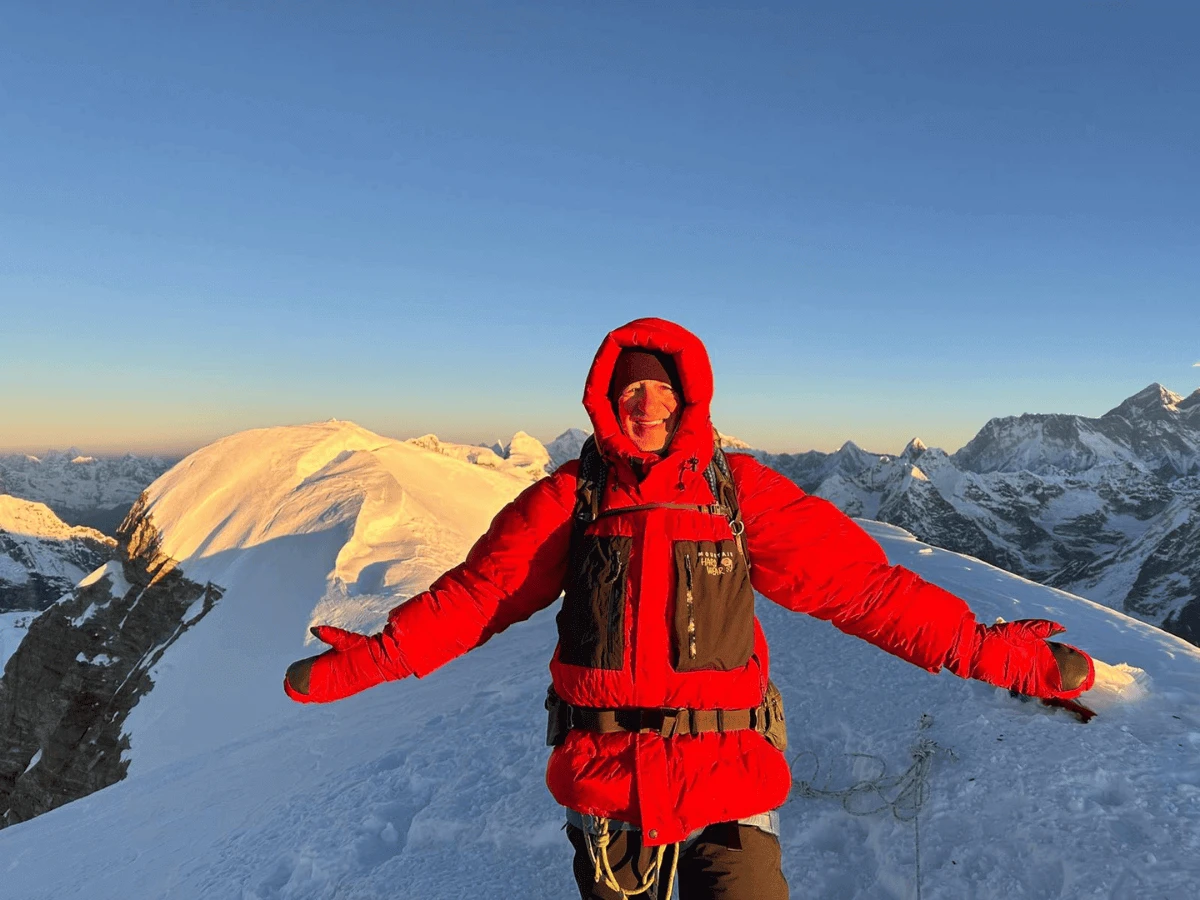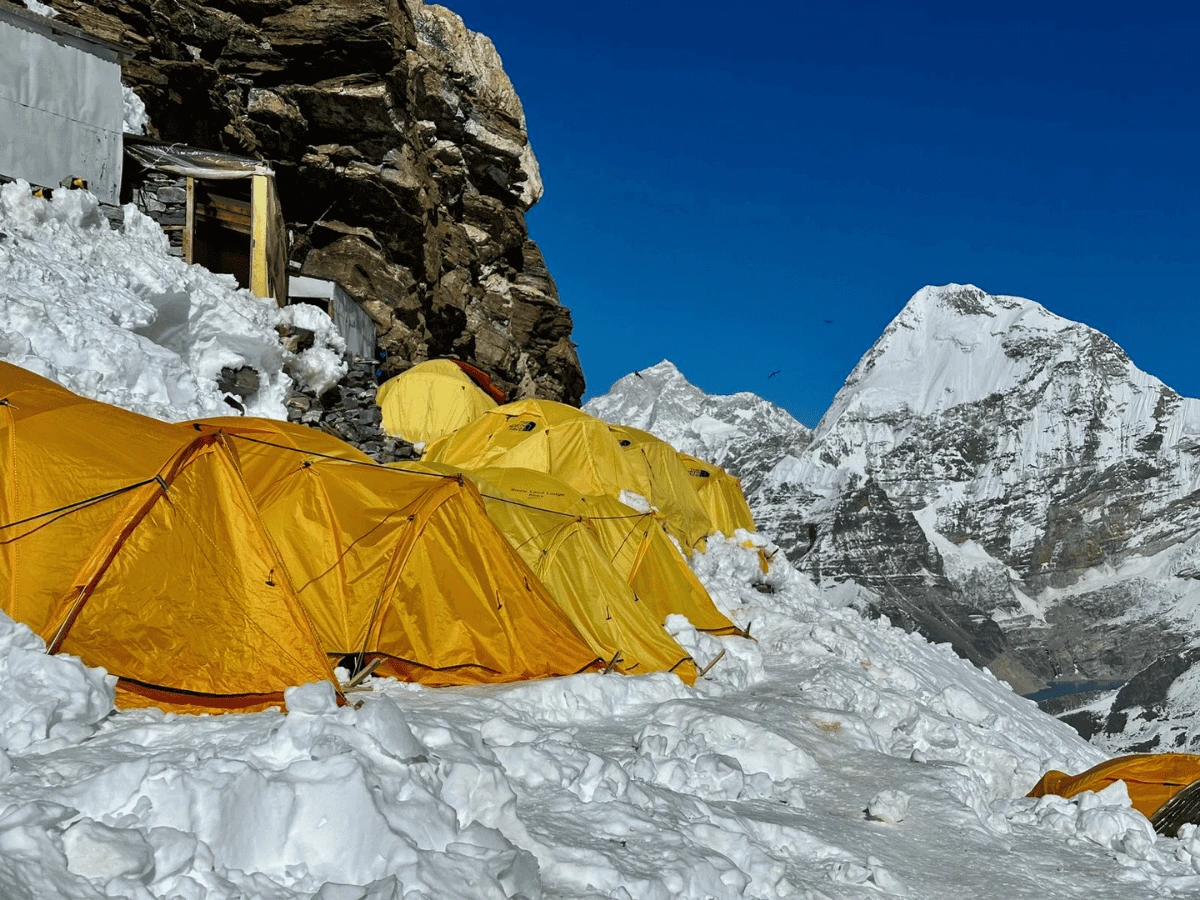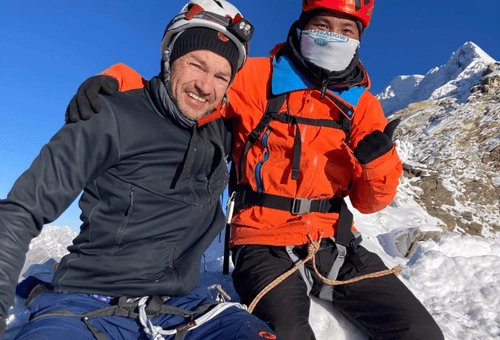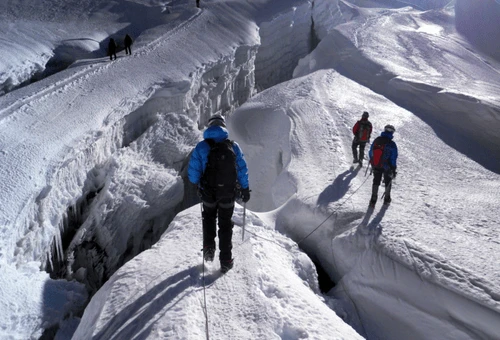Mera Peak Climbing (6,476 meters) is renowned as the highest trekking peak in Nepal. Mera Peak is located in the remote Hinku Valley of the Mahalangur Himalayas. This is a thrilling Himalayan trek with a non-technical mountaineering ascent. Trekking through lush rhododendron forests, traditional Sherpa villages, and high alpine terrain, it takes you to the summit of Mera within 12-14 Days. Reaching the top is a genuine mountaineering adventure in Nepal, rewarding climbers with panoramic views of Everest,Lhotse, Ama Dablam, Pumori, and many other peaks.
Mountain Eco Trails, a leading & best local trekking company in Nepal with over 10 years of experience in the trekking and climbing field, organises the Mera Peak expedition with an emphasis on safety, sustainability, and personal achievement.
Our team’s expertise and commitment to eco-friendly practices ensure that your Mera Peak climbing trip is both memorable and responsible. Whether you are a seasoned trekker aspiring to achieve your first Himalayan summit or an avid climber looking for a new challenge, Mera Peak offers an unforgettable blend of natural beauty, cultural encounters, and high-altitude excitement.
How hard is Mera Peak Climbing in Nepal?
Mera Peak Climbing is considered a moderate to challenging adventure in the Everest region. The altitude of the peak makes it more challenging than its technical section. In mountaineering terms, Mera Peak is rated Alpine Grade PD (Peu Difficile). That indicates it’s not technically difficult. You don’t need advanced climbing skills to reach the summit – most of the route involves a steady glacier walk with a few steeper sections.
Basic mountaineering techniques such as walking in crampons and using an ice axe will be handy, and our guides will provide training on these during the trip.
The main challenge is the thin air at higher elevations. The elevation of Mera Peak is 6476, which can be challenging even for fit climbers. That’s why acclimatisation is essential; our itinerary includes a rest day at Khare (5,045m) to help your body adjust. All climbers should be in good physical condition, capable of walking 6–7 hours a day in hilly terrain. Previous high-altitude trekking experience, like the Everest Base Camp Trek 14 Days, would be very beneficial.
With strong determination, good fitness, and support from our experienced Sherpa team, Mera Peak Climbing is achievable for anyone ready to push their limits. Many first-time climbers use Mera Peak as an introduction to Himalayan mountaineering; it’s challenging but doable, and incredibly rewarding.
Mountain Views from the Summit of Mera Peak
One of the major highlights of the Mera Peak expedition is the spectacular panorama from its peak. On a clear morning, climbers are rewarded with a 360° view of the Himalayas, including five of the world’s highest mountains. From Mera’s summit, you can see Mount Everest (8,848.86m) towering to the north, as well as Lhotse (8,516m), Cho Oyu (8,201m), Makalu (8,485m), and even distantKangchenjunga (8,586m) on the eastern horizon. Standing at 6,476m, you have the Himalayas at your feet—an awe-inspiring sight that few trekking peaks can rival.
This expansive vista is a major reason Mera Peak Climbing is so popular, as it offers arguably one of the best viewpoints in Nepal.
How long does it take to do the Mera Peak Climb?
The duration of a Mera Peak Climb depends on your flexibility and where you want to start. However, most of the Mera Peak Itinerary range from about 12 to 18 days, depending on the route taken and the number of acclimatisation days.
At Mountain Eco Trails, we offer a carefully designed Mera Peak Climbing from Kathmandu 12-Day Itinerary that provides sufficient time for a safe climb. This includes 9 days of trekking/climbing from Lukla to Mera summit and back, plus 3 days for the Kathmandu–Lukla flights and any buffer. By using the direct route via Zatrwa La Pass and including an acclimatisation day at Khare, we’re able to complete the trip in 12 days without rushing.
12-Day Mera Peak Climbing Route Map Itinerary
Our 12-day Mera Peak itinerary is thoughtfully crafted to provide an exhilarating Himalayan experience while ensuring proper acclimatisation and safety throughout. The adventure begins with a scenic flight from Kathmandu to Lukla (2,860m), followed by a gentle trek through forested hills to Chutanga (3,020m).
On the second day, we tackle the challenging Zatrwa La Pass (4,610m) before descending into the Hinku Valley to reach Thuli Kharka (3,900m). From there, we journey through pine and rhododendron forests to Kothe (3,600m), then continue alongside the glacial Hinku Khola to Thangnak (4,358m), taking in breathtaking views and stopping by turquoise alpine lakes along the way.
The trail leads us up moraines to Khare (5,045m), our Mera Peak base camp, where we prepare and rest for the summit attempt, including an acclimatisation day for safety. We then ascend to Mera High Camp (5,780m), a spectacular vantage point with panoramic views of Everest, Makalu, and other Himalayan giants.
The summit day begins early with a steady climb on snow slopes, culminating at the top of Mera Peak (6,476m), Nepal’s highest trekking peak, before descending back to Khare for a well-deserved celebration. Retracing our steps, we descend to Kothe and then back to Thuli Kharka, crossing the Zatrwa La once more before reaching Lukla. After a night of celebration with our trekking team, we fly back to Kathmandu, wrapping up this unforgettable adventure through Nepal’s remote and rugged wilderness with memories that will last a lifetime.
Mera Peak Climbing Cost 2026,2027
Mera Peak Climbing cost can vary based on several aspects, including the itinerary, group size, and services included. However, the average Mera Peak expedition cost ranges from USD 2500 to 2800 per person. The cost typically covers all major expenses for the trek and climb: the climbing permit and national park fees, round-trip flights between Kathmandu and Lukla, an experienced climbing guide (licensed Sherpa guide), necessary support staff (porters, cooks), all trekking meals and teahouse accommodations, group climbing equipment, and other operational expenses.
Why choose Mountain Eco Trails for the Mera Peak Climb in Nepal
The team of Mountain Eco Trails has expertise with over 10 years of experience in trekking and peak climbing. Our Sherpa Guide ensures that you will complete the summit, focusing on the safety of our valuable climbers. Moreover, we offer a competitive price that matches the quality of service we provide to our clients, with no hidden prices at all. Here are the reasons why you should choose us for the Mera Peak Climbing:
- Skilful, experienced, and strong crew members, including a climbing guide
- Climbing Equipment from Khare, like Ice-Axe, Harness, Crampons, Ascender, Descender Lock, etc.
- Peak Climbing Achievement Certificate
- First Aid Kid is carried by a climbing guide.
- Free Mera Peak Climbing Route Map
- Flexible Mera Peak Climbing Itinerary
- Constant communication with climbers and staff members.
- Free luggage storage at Mountain Eco Trails during the trip.
- Complimentary services like Duffel Bag, SIM Card, an hour of massage, and many more.
If you have any confusion regarding this trip to Mera, feel free to contact us via WhatsApp for better communication at +9779849790153.





